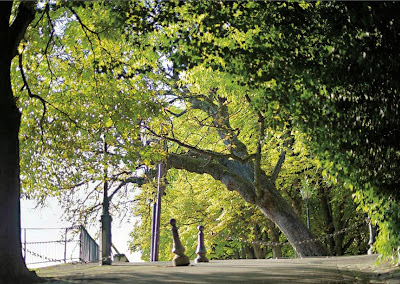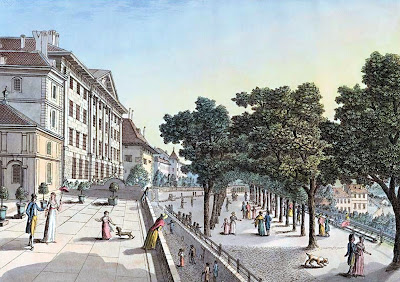Well, there are actually two official dates for the beginning of spring. The meteorological date is always March 1.
I recently read an article in Die Zeit referring to a local date for the start of spring in Hamburg. This brought back memories.

|
| La Treille today (©Loris von Siebenthal) |

|
| La Treille then (©Bibliothèque de Genève) |
Poor Genevans in the 1800s! They suffered terrible cold weather in addition to the French occupation, which ended with severe winter as the Cossack winter. The worst was still to come in 1816 with a summer without the sun; the sky remained darkened by the dust of the colossal explosion of the Tambora volcano in Indonesia, which was unknown at the time.
In poorly heated houses, long and dark nights, watching the chestnut tree with its first leaf announcing spring - some must have feared that it would not return - brought the hope of beautiful days.

|
| ©Loris von Siebenthal |

|
| ©Bibliothèque de Genève |
Back to Hamburg. When in this port city, a forsythia shrub near the traditional Lombardsbrücke* is in bloom, then there is officially the beginning of spring.
*Spanning the water link between the two lakes formed by
Außen- and Binnenalster
Forsythia is an indicator plant blooming when there is no more frost. The soil has to be warm at seven degrees centigrade, even at night, because the roots won't absorb any water before then. So the most accurate determination of the beginning of spring is phenology based on the flowering, for the plants feel what man cannot determine.
Die Zeit continues, "The man reporting the beginning of spring is Jens Iska-Holtz; he is
81 years old. He has been coming here for 37 winters, every day in
January, February, and March, to his forsythia, a family of oil-leaf
plants, two meters wide, three meters high. This story can only be told as that of the two of them. Without the old man, the shrub is
nothing, and the old man is nothing without his shrub. "
Jens is one of 1100 phenological observers in the land reporting to the head office of the German Weather Service located in Offenbach near Frankfurt. Most of them look at and serve as messengers for whole regions; Jens only looks at his shrub.
Red Baron has a personal phenology spring indicator looking out of his kitchen window. Every year a splendid magnolia tree starts to blossom from the end of February to the beginning of March. This year it is unusually cold for the season – we were spoiled by climate change in recent years – the first buds became visible on the ides of March. Spring has finally
arrived in Freiburg!
Forsythia is an indicator plant blooming when there is no more frost. The soil has to be warm at seven degrees centigrade, even at night, because the roots won't absorb any water before then. So the most accurate determination of the beginning of spring is phenology based on the flowering, for the plants feel what man cannot determine.

|
| ©Die Zeit |
Jens is one of 1100 phenological observers in the land reporting to the head office of the German Weather Service located in Offenbach near Frankfurt. Most of them look at and serve as messengers for whole regions; Jens only looks at his shrub.
*

No comments:
Post a Comment